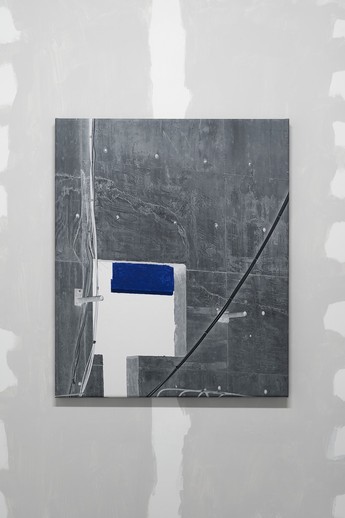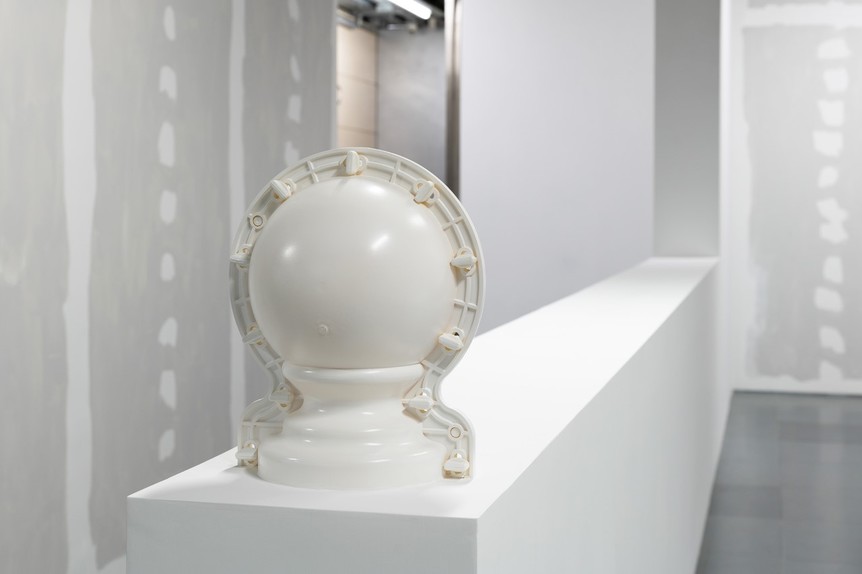-
From Current Issue
-
- Editor’s Letter Fire in the Heart
- Reviews I Gusti Ayu Kadek Murniasih
- Reviews 11th Seoul Mediacity Biennale: “One Escape at a Time”
- Dispatch Networked China
- One on One Monira Al Qadiri on Yukio Mishima
- Essays The rise of independent art spaces in pandemic-era Shanghai
- Features Tuan Andrew Nguyen
- Table of Contents
- Web Exclusives
- Archive
- Subscribe

R
E
V N
E
X
T
Installation view of KO SIN TUNG’s “Adaptation,” at Edouard Malingue Gallery, Hong Kong, 2019. All images courtesy the artist and Edouard Malingue Gallery, Hong Kong / Shanghai.
At the entrance of Hong Kong’s Edouard Malingue Gallery was a bizarre photo depicting a single lump of adhesive putty. The humble, pliant tool, framed against a gray background in the close-up, is usually in the hands of artist Ko Sin Tung, who has the habit of kneading the sticky material while she works at her table. Her fingerprints are imprinted on the partially stretched ball, which, upon closer inspection, appears to be composed of different hued putties that have been folded in together, suggesting the mass’s aggregation over time. This image succinctly conveyed the themes of Ko’s second solo exhibition at the gallery, “Adaptation.”
In the show, Ko further explored states of transformation and transition through works that evoked in-progress constructions of different scales. Walking deeper into the space, one was surrounded by what appeared to be drywall. The artist had created this illusory effect by painting the gallery’s walls gray, adding streaks of white paint that framed the supposed edges of the individual drywall sheets, and dotted white lines that ran down the centers of these “panels.” These marks were intended to suggest the rawness and messiness of construction areas—sights that are usually blocked from the public’s view. Another common quality in yet-to-be-complete buildings, darkness, was the subject of Ko’s hybrid painting-photography series, From dark to light (2019). The five canvases each show gray, concrete walls with windows, and color blocks seemingly floating “outside” of the openings. It appears as though the scenes were captured from within a building. However, what viewers are looking at are in fact the exterior hoardings of construction sites. Such confusion between the interior and exterior spaces was achieved by several layers of transformation. First, Ko inverted the light and shadow in her original photos of the site. Then, she pixilated the photo, rejecting the popular pursuit of high-definition displays—a technique often seen in her works. This manipulated image was subsequently printed onto the canvas before Ko painted the patches of beige, brown and indigo, which symbolize the lives that might adapt to these spaces in the future. With the building standing in metaphorically for a person, Ko prompts the audience to reconsider the invisible processes of transformation that occur within an individual. The positioning of the works further emphasized a sense of ongoing change. The canvases were either hung on the wall or propped up on squares of polyethylene foam and leaned against the partitions, as if the installation was not yet finished.
Incompletion could also be seen at the center of the gallery. There, a mold for a feng shui sphere was placed on top of a seemingly half-built, one-meter-tall stretch of wall. Traditionally, a running stream of water would move the ball, symbolizing money flowing into the household, but the orb stood immobile in the exhibition. Other molds—for a Roman flowerpot and pillars—could be spotted in different corners of the space. Ko transformed these cheap and easily obtained tools, typically only used as means of forming other products, by spraying them in white paint, before fixing them to the gallery interiors, thereby positioning them as finished displays of art. Ko thus challenges the expendability—perhaps the antithesis of adaptability—of objects within cultures of mass production. Elsewhere, in the inner section of the gallery, was Arrow (2019), a floor-based installation of two blue road signs held up by G-clamps—another device usually removed once the object is stabilized. Ko had blurred the arrows on the signs by layering over them with sheets of plastic, and left the bubbles trapped under the plastic’s surface intact.
Adaptation is required for survival, but the processes of this mechanism are often neglected in society at large and in the art world. By highlighting the transitive states of objects, Ko not only proposes the adaptive potential of the media employed in her works, but also questions the “finished” state of a contemporary art exhibition.
Pamela Wong is ArtAsiaPacific’s assistant editor.
Ko Sin Tung’s “Adaptation” is on view at Edouard Malingue Gallery, Hong Kong, until August 9, 2019.
To read more of ArtAsiaPacific’s articles, visit our Digital Library.


















